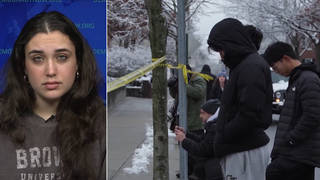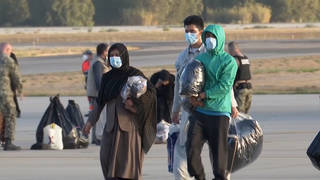
Topics
Guests
- Kathy Gannonaward-winning Associated Press correspondent who has covered Afghanistan and Pakistan for over two decades. She is the author of I is for Infidel: From Holy War to Holy Terror, 18 Years Inside Afghanistan.
Links
Civilian deaths in Afghanistan from US and NATO air strikes have nearly tripled from 2006 to 2007, according to a new report by Human Rights Watch. Air strikes killed at least 321 civilians in 2007, compared with at least 116 in 2006. The tally for this year is expected to be even higher. We speak with Kathy Gannon, an award-winning Associated Press correspondent who has covered Afghanistan and Pakistan for over two decades. [includes rush transcript]
Transcript
AMY GOODMAN: The top US military commander in Afghanistan has called for an investigation into reports that over ninety civilians were killed in US air strikes on an Afghan village last month. General David McKiernan requested a review of the American military investigation into the attack Sunday, citing “emerging evidence.” He did not elaborate on the evidence, but Afghan and Western officials have told journalists there is video from the aftermath of the August 22nd air strike that shows dozens of dead civilians.
The Afghan government and the UN mission in Afghanistan both concurred with villagers’ reports that at least ninety civilians — two-thirds of them children — were killed in the air strike. But the initial US military investigation released Tuesday concluded that no more than forty-two people had been killed, of which only seven were civilians — the rest, Taliban.
Afghan President Hamid Karzai visited the affected village of Azizabad on Thursday. He paid his respect to the mourners and condemned the air strikes.
PRESIDENT HAMID KARZAI: [translated] I have been working day and night over the past five years to prevent such incidents. But I haven’t been successful in my efforts. If I had succeeded, the people of Azizabad wouldn’t be bathed in blood.
AMY GOODMAN: Afghan President Hamid Karzai has also ordered a review of whether the US and NATO should be allowed to use air strikes and carry out raids in villages.
The August 22nd attack is only one in a series of US and NATO air strikes that have caused high numbers of civilian deaths. According to a new report from Human Rights Watch, the increased use of air strikes has tripled civilian deaths in Afghanistan over the past year. Last week, hundreds protested an air strike in Kabul that reportedly killed three members of a family: a man named Noorullah and two of his infant sons, one of whom was only eight months old. This is Salman Shah, a relative of the three victims.
SALMAN SHAH: [translated] Are those two children al-Qaeda or Taliban? Do they have guns to fight? Why should they be killed? This proves that these Americans, these Christians, are here to kill a generation of Afghans.
AMY GOODMAN: Kathy Gannon is an award-winning Associated Press correspondent who has covered Afghanistan and Pakistan for over two decades. She is the author of I is for Infidel: From Holy War to Holy Terror, 18 Years Inside Afghanistan. Kathy Gannon joins me now on the line from Islamabad, Pakistan.
Welcome to Democracy Now!
KATHY GANNON: Thank you very much. It’s a pleasure.
AMY GOODMAN: It’s good to have you with us. You have just written a piece called “Afghans Fed Up with Government, US.” Explain what you have found in Afghanistan.
KATHY GANNON: Yeah, I just got back, actually, from Afghanistan. I traveled around quite extensively in the east, in Nangarhar, eastern Nangarhar province, and in northeastern Kunar province. And really, you know, I mean, without exception, everyone I spoke to were so frustrated after seven years with the way — with the corruption in their own government and the lawlessness that exists in Afghanistan and with the heavy-handed approach of the US and coalition and NATO forces, in terms of air strikes, in terms of errant raids, in terms of picking up people for questioning, picking up people who they think are suspicious, that fit a profile. There was just a tremendous degree of frustration, because these are people who really were happy to see the back of the Taliban and really are not — don’t want to embrace the Taliban.
But they are so frustrated and so fed up, and one old guy said to me, he says, you know, “Where can I go?” He says, you know, “I’m almost afraid to sleep at night, because somebody is going to come into my house and take my son.” So it’s — and it’s been seven years, and while it’s a very difficult operation and a difficult place in which to operate, after seven years, instead of people feeling that it’s moving in the right direction, there’s just such a degree of frustration, which contradicts the tremendous hope that they did have at one point.
AMY GOODMAN: Civilian deaths now, according to Human Rights Watch, which put out a report today, have nearly tripled since 2006, the tally for this year expected to be even higher.
KATHY GANNON: Yeah. You know, it’s hugely problematic, because the use of air strikes as a backup, as — to target houses is inevitably inaccurate and has proven to be inaccurate. And what one person was saying to me is that, you know, the strategy is between, you know, well, the use of air strikes to save only the lives of the international soldiers versus not using them, which would reduce the number of Afghan civilian deaths. And so, the choice is made, and the choice is made to use the strikes.
And it’s not that they intentionally target civilians. Of course not. But the thing is, is if you drop a bomb on a house and then you say, “Well, they shouldn’t have been hiding among those people,” well, you know you’re going to have civilian casualties. These people that you’re targeting, they might not be Taliban and such that follow Mullah Omar, but they’re against you. They come from those villages. They’re among their families. They’re with their families. Or you’re just getting bad information, because seven years out, you don’t know. You don’t have a good intelligence network after seven years.
And so, the choice — two things. The choice is, is that you have to — force protection. At all cost, you protect the lives of your soldiers. Well, of course, the soldiers’ lives are important. But then, as a result, you might — somebody fires a Kalashnikov; you return with a twenty-minute barrage, and you kill twenty people to get that one person who fired a Kalashnikov in your direction. Or somebody comes at your convoy, and because you fear it might be a bomber, you kill the entire group of people in the car. So that strategy of force protection means that the force is more — their lives of the force is more important than the lives of the civilians. And so, you end up with a great number of civilian deaths.
There just has to be a rethinking of the strategy, and, you know — and the use of air power, and President Hamid Karzai — and I saw him three weeks ago — said too that, you know, the use of air strikes has got to be either curtailed, according to him, or has to be really much, much more strategic. You can’t go to try to take out one person and drop a 2,000-pound bomb in an area. You will have civilian casualties.
AMY GOODMAN: And what about this latest news, Kathy Gannon, of General David McKiernan requesting a review of the American military investigation into the attack that looks like, at least according to the Afghan government and the UN mission, ninety civilians were killed, sixty of them children, the US government insisting that seven civilians were killed?
KATHY GANNON: Yeah. Well, see, this is also part of the problem. Yeah, I mean, you had the UN went, and they said that it was as many as ninety civilians dead. The Independent Human Rights Commission of Afghanistan also, the government also — that’s three. And then, belatedly, the US then says, “OK, let us rethink it.” For Afghans, they then get the sense that their lives are somehow not as valuable as the international forces or as the — and belatedly, then to say, “Well, maybe we better investigation.” And I know that they go and apologize, and they — but there is that sense among Afghans that, you know, the first reaction will be that, no, they killed militants, they didn’t kill civilians. No matter what the civilians say, no matter how much evidence they present, they say no and then, OK, belatedly, say, “Well, let me check.” Well, you know, if ninety people might have been dead, two weeks later or three weeks later, you then say, “Gee, maybe we should do a more thorough investigation.”
And Afghans also say, “Well, then, who is punished? If ninety people were killed, or even four people or five people, you know, who’s punished? Who gave you the wrong information? How did you get the wrong information? How was it that you attacked that area? Where did that information come from that said that it was a house full of militants? Who told you that you only killed thirty militants and seven civilians?” And even seven is still — you know, any death is, of course, horrific. “Who gave you that information, and why is nobody held responsible?” And this is what Afghans, without exception, Amy, were saying when their families were affected, their areas were targeted.
People are — people today, even though they don’t want the international forces to go, because they’re afraid of what’s going to be left behind, because it’s such a mess — not just Taliban, but corruption, the lawlessness, the warlords, that has grown out of proportion or grown so greatly since 2001. So they’re afraid of what is left. But that’s why they don’t want them to go.
And at the same time, they’re afraid now of the international forces. It used to be — really it used to be, five, six, seven years ago, they looked at the international forces with hope. Today they’re afraid. They see them, they say, “Oh, no, please, don’t. You know, there’s no Taliban. Please don’t hit us. Please don’t take our young men. Please don’t.” You know, I mean, and that — and many Afghans say, “You know, when the international forces see an Afghan face, they automatically don’t trust them. They automatically see an enemy.” And ordinary people say, “Well, you know, if they see me as an enemy, then how can they help me?”
And so, you know, there’s a real — seven years on, there’s a real need to rethink strategy, to really look at what the strategy is, what the end game is, who the enemy is, and how to move forward, because as it is, people are really — Afghans, ordinary Afghans, who had tremendous, tremendous hope, tremendous faith in the international community, feel really, really disappointed on so many fronts, on the front of their own government —-
AMY GOODMAN: Kathy Gannon, we’re going to have to leave it there. I want to thank you very much -—
KATHY GANNON: Sure.
AMY GOODMAN: — for being with us, award-winning Associated Press correspondent, has covered Afghanistan and Pakistan for over two decades. Her book is I is for Infidel: From Holy War to Holy Terror, 18 Years Inside Afghanistan.













Media Options